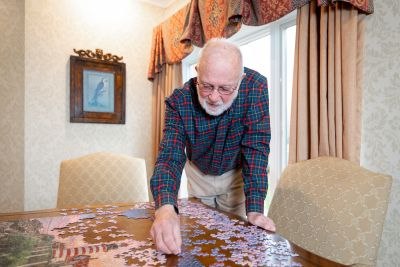 Studies show that social isolation and loneliness is becoming a bit of an epidemic among older adults, and it can have a severe impact on one’s overall health. But there is actually an important distinction between social isolation and loneliness. Consider that while some people like to be at the life of the party at all times, others are perfectly happy to spend time in solitude—perhaps reading, working on a hobby, or meditating quietly with their thoughts. They are alone, but they don’t feel lonely.
Studies show that social isolation and loneliness is becoming a bit of an epidemic among older adults, and it can have a severe impact on one’s overall health. But there is actually an important distinction between social isolation and loneliness. Consider that while some people like to be at the life of the party at all times, others are perfectly happy to spend time in solitude—perhaps reading, working on a hobby, or meditating quietly with their thoughts. They are alone, but they don’t feel lonely.
Thus, while loneliness can be closely related to social isolation in many people’s minds, there is a distinction. Social isolation is about lacking interactions with other people, and there is no doubt that as social creatures, all humans do need this type of connection. This requirement can be met, however, by talking with others, either in person or virtually, online or on the phone. It can be appeased by simply interacting with people in the world around us.
Loneliness, however, is more about feeling a sad sense of solitude in the world. It brings to mind the phase, “alone in a crowded room.” Loneliness is often triggered by some type of a loss. Loss of mobility, health, or hearing perhaps. Maybe the loss of a lifelong career, or the loss of a spouse, friends, and family. In a vicious domino effect, this sense of loss can result in depression and cause the senior to pursue even fewer opportunities for social interactions, thus increasing their isolation and loneliness as they feel their purpose in life is dwindling.
The health risks of loneliness
A 2012 study out of the University of California’s department of geriatrics found 43 percent of the study’s 1,604 senior (age 60 and older) participants reported feeling lonely at least some of the time.
Of the people in the study who felt lonely, they were almost 25 percent more likely to experience a decline in activities of daily living (ADLs), and they were roughly 40 percent more likely to develop difficulties with upper extremity tasks, experience decline in mobility, and have difficulty in climbing stairs. Overall, loneliness was associated with a nearly 23 percent increase in risk of death.
Other research studies have found that loneliness among seniors is correlated to additional negative health consequences such as increased risk of coronary heart disease, higher rates of stroke, and an increase in rates of dementia.
But it’s also important to know that the health implications of senior loneliness can extend to those around the person, impacting the stress levels of caregivers and loved ones as well. These people often can feel they must shoulder the intense burden of trying to fill this loneliness gap for the senior, and it can feel overwhelming, especially on top of the already heavy-load of caregiving.
Strategies for addressing loneliness
But there are options to mitigate against senior loneliness. We as a society must actively look for ways for seniors to remain active and engaged in the world around them, such as improved public transportation or ride-sharing options and more diligent screening procedures to uncover and address feelings of loneliness sooner. Participation in volunteer opportunities and intergenerational programs designed to bring together seniors and younger people also can ensure seniors stay involved and continue to form new relationships, thus helping to stave off feelings of loneliness.
The opportunity to socialize with peers is one of the many benefits of residing in a senior living community, such as CCRC. Not only do these communities offer a large group of potential friends who are in a similar place in life, they also offer numerous scheduled events and activities to residents—everything from happy hours, to cooking and fitness classes, to affinity groups that encourage a common hobby or interest.
In fact, one of the most common refrains expressed among residents at continuing care retirement communities is the importance of the sense of community and social connections developed among residents.
Loneliness among seniors isn’t inevitable. In fact, it is both preventable and curable. We must simply look for opportunities to help seniors continue to nurture existing relationships and form meaningful new ones.
